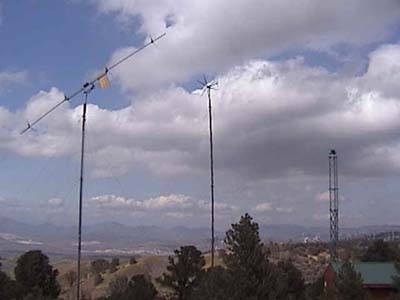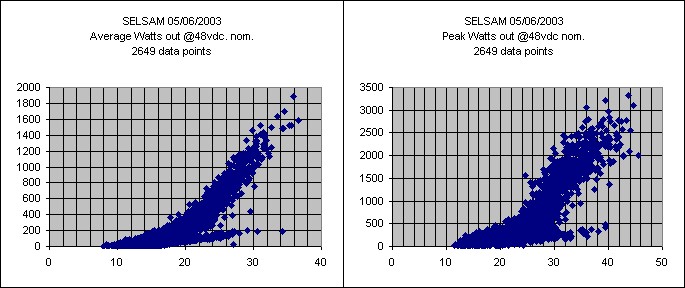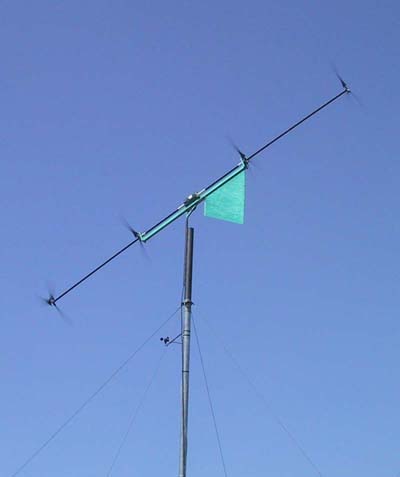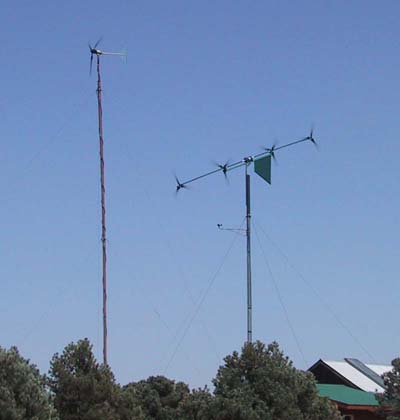
Experimental Prototype Selsam Wind Turbine with four 4-foot diameter rotors (left).
Technical Data
Rotors: 4
Rotor diameter: 4 FEET
Generators: 1
Power graph:

Power curves for a Selsam Multi-Rotor Wind Turbine with four 5 foot diameter rotors show a solid 1000 watts average power output at 28 - 29 mph. This is at 5000 feet elevation in Tehachapi, CA, where the air is about 14% thinner than at sea level. Most "1000 watt" turbines will actually average only about 600 watts at this windspeed, even if the data is corrected for altitude. Notice that at 35 mph, where most small wind turbines are producing very little power due to sideways furling, we are producing 1600 average watts - 2000 average peak watts. U.S. Patent Number 6,616,402 and other patents pending including international (PCT) http://www.uspto.gov

Selsam Turbine with four 4 foot diameter rotors furling to a horizontal configuration at about 30 mph, still producing full power. Downwind rotors are protected by the slipstream of the upwind rotor, limiting power production and thereby protecting from a runaway situation which would burn out the generator. This stops what would otherwise be a geometrically climbing power curve and begins to level it out above the rated wind speed. Conventional "1000 watt" turbine can be seen furling sideways in background, "cringing" at the force of this strong wind, and consequently producing very little electrical power when the wind speed is above the rated speed, where the best opportunity for producing power actually exists.

This "1 kilowatt" model produces 1200 watts at 33 mph
We see peaks of up to 1400 watts at 33 - 34 mph
New highest peak 1686 watts at ~34 - 35 mph!
We're calling this one the "Quadrunner" - We're pleased to see this prototype running very smoothly during the first few months of preliminary testing. Utilizing four 45" diameter sets of Air-X blades from Southwest Wind Power, placed approximately 7 feet apart, it's up and producing power during the first few weeks of operation. Preliminary readings show 800 watts at 27 mph, 1000 watts at 30 mph, and 1200 watts at 33 mph. We've seen peak output of 1400 watts at ~34 mph, and 1686 watts at wind speeds of ~35 mph. The generator is a dual-shaft 1 hp PM DC motor specially fabricated for us by Leeson Electric. In high winds, we are pushing this motor/generator over its designed power rating, as we had hoped we would, but it is well-cooled by the flow of wind, so it can handle the extra amps. The filament-wound carbon fiber driveshaft for the compound rotor is from Advanced Composites Products and Technology in Huntington Beach, CA. The frame is welded steel, as per the "heavy metal" design philosophy. Note that we are now utilizing a tail for quicker response to changes in wind direction. It is tracking perfectly. (Note: U.S. and International Patents issued and pending)

Here's the "Quadrunner" beside a Whisper H-40 from SWWP, which is a bit further from the camera, at the testing facilities of Windtesting.com. According to Brent Scheibel, founder and Chief of Operations at Windtesting.com, the two turbines are generating comparable amounts of power. The new "Quadrunner" has a much faster rotational speed (RPM), and so far makes a pleasant sound - not too loud either.